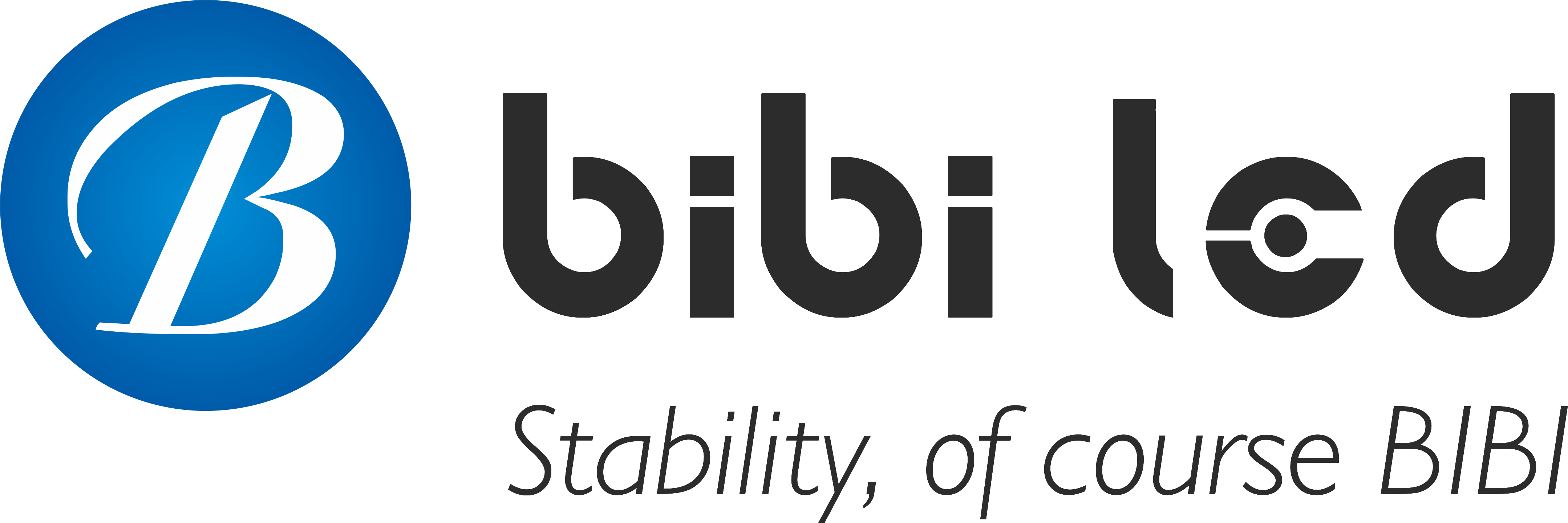مقدمة
جدول المحتويات
Method 1: "Anti-routine" thinking of size and position
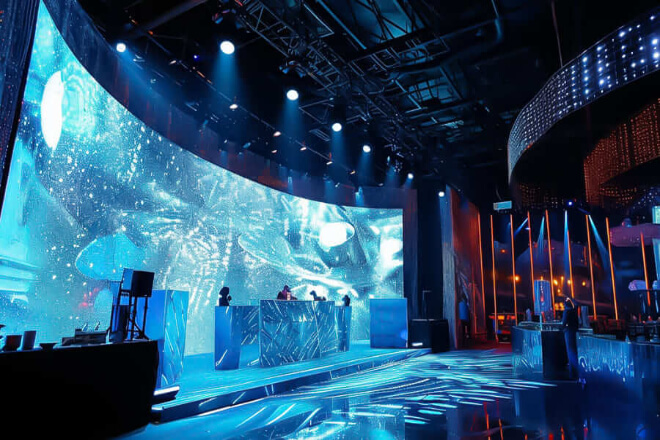
When it comes to using LED screens in bars, the first reaction of many people is: it should be big! It should be bright! It’s better to flash a little more. But is it really useful?
In fact, many times, the more “forced presence”, the easier it is to make people feel embarrassed – it is overwhelming, uncoordinated, and a bit rustic.
Now, more and more stylish and assertive bars are playing “anti-routine”: the screen does not need to be large, but it is important to use it skillfully.
For example, a slender small screen is embedded under the bar, and it gently moves with the rhythm of the music. Guests can feel the atmosphere moving as soon as they lower their heads.
Or you can put a small screen in the wine cabinet, and loop the slow-motion footage of the cocktail mixing process and the limited edition wine recommendation, which will not disturb people but attract people inadvertently.
Some designs are more “hidden, and the LED screen is installed as part of the light at the edge of the ceiling, behind the mirror, and at the corner of the wall. If you don’t tell me, you really can’t find it.
But when the content lights up, it just “lights up” at the edge of the customer’s visual blind spot.
The feeling of “Huh? What did I see just now?” is more memorable than directly covering the entire wall.
This combination of small screen + ingenuity is actually very suitable for bars that don’t want to take the “traditional commercial route”.
It can provide necessary information transmission (such as menus, wine recommendations.
And event reminders) without destroying the aesthetics and atmosphere of the overall space, and can even become a “private and exquisite” interactive method.
In the final analysis, the LED screen is not used to steal the spotlight, but to “embed into the experience”.
Instead of thinking about how to “show your presence”, it is better to think about how to “just be seen”.
A small screen, lit up in the right corner and at the right time, is more impressive than any giant screen.
Method 2: Learn to use colour "subtraction aesthetics"

When many bars use LED screens, the easiest pitfall is that there are too many colours, too messy, and too bright.
The result is that the space that could have been very design-oriented has become a colourful nightclub style. If you are not careful, you will slide from “fashion sense” to “poor quality sense”.
In fact, in truly advanced visual expressions, the more restrained the use of colours, the more texture it appears.
Especially for self-luminous media such as LED screens, the more saturated and contrasted, the easier it is to appear cheap.
If the background itself already has many light sources and lighting changes, then the LED screen should be “subtracted” to make it part of the atmosphere, rather than an external element that disrupts the rhythm.
A very practical approach is to use black, white and grey as the base, and then match the brand’s own main colour.
For example, if the main colour of the bar is dark red, the content of the LED screen can be based on black, white and grey, and the key elements can be embellished with dark red. This is not only unified, but also instantly brings out the tone.
The content of the LED screen does not need to be “blinding” in every frame. Low سطوع + soft colour temperature makes it easier for people to stop and watch, and they will not feel tired after watching for a long time.
For example, some bars will switch to the “text projection mode” with black background + white text in the evening, scrolling brand quotes, recommendations of the day.
And even anonymous messages randomly sent by guests. This method is not only visually very restrained.
But it is easier to resonate. It is not to “attract everyone’s attention”, but to make those who understand it stop and take a closer look.
“Subtractive aesthetics” does not mean less content and simple design, but to play with layers and atmosphere in limited colours.
The changes in light and shadow, the choice of fonts, and the rhythm of white space are all small details that can make the LED screen more “enduring”.
So, if you don’t want your bar to look like a KTV box or a low-profile nightclub, the first step is to start with colour.
Put aside the old idea that “the flashier, the cooler”, learn to “speak” with colours, use low-key, and win a sense of luxury.
Method 3: Content is the soul

Many bars often make the mistake of using LED screens, that is, using too many colours and too many mixed colours, which makes them look like cheap replicas of nightclub style.
In fact, the more colours, the cooler it is. On the contrary, it is easy to make the space messy and lose its texture.
A simple and effective idea is to use “subtractive aesthetics” – using black, white and grey as the background colour, and then matching the main colour of the brand, which can instantly raise the overall sense of fashion.
The content of the LED screen does not need to be highly saturated. Low brightness and soft colours are more durable and can better integrate into the atmosphere of the bar.
For example, some bars will use a black background and white text design to play recommended menus and brand stories, and the key content will be embellished with brand colours, which is both unified and highlights the key points.
This not only avoids visual fatigue but also makes information transmission more accurate, and customers are more likely to focus on the core content.
In addition, the low-brightness picture can also echo the lights in the bar, creating a rich layer of light and shadow effects.
Instead of making the screen a “highlight”, it is better to make it a “light and shadow role” in the space, which changes gently with the ambient light, bringing a sense of immersion and quality.
In general, let go of the old thinking of “the brighter the better” and learn to restrain the use of colours, so that the LED screen can truly become a texture plus point in the bar space, rather than a visual burden.
Method 4: The LED screen and the bar space style should be "in tune"
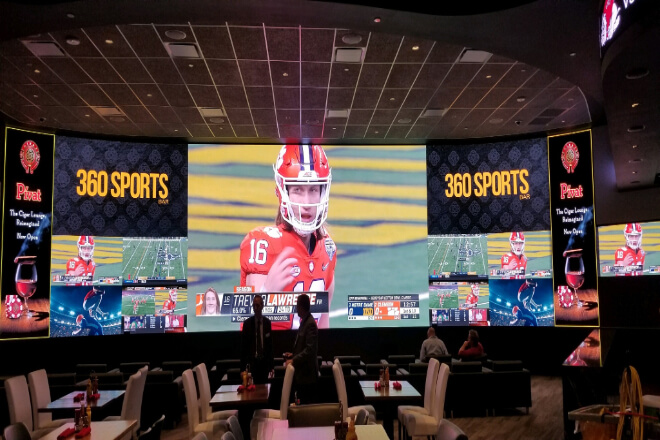
No matter how dazzling the LED screen is, if it does not match the overall style of the bar, the effect is often greatly reduced.
The requirements for screen design in bars of different styles are actually very different. Industrial style, retro style, and minimalist style, the “dressing” of the screen is all different.
For example, industrial style bars often use rough metal and exposed pipes. At this time, the frame of the LED screen is best to use black or dark grey.
It can even be made into an antique style with a rust texture, which is unified with the wall and decorative materials to avoid the “hard” plastic feeling, and the overall coordination is more coordinated.
For retro style, you can choose an LED screen design with a wooden or antique copper frame, or even make it into the shape of an old radio or billboard.
The screen content is matched with nostalgic fonts and colours, and the atmosphere is naturally overwhelming.
Minimalist-style bars pay more attention to hiding and simplicity. An LED screen does not need too many frames, and it can even be embedded in the wall or made into a frameless glass screen to blend with the wall.
The screen and wall materials and colours are kept consistent, weakening the presence of the screen, so that information transmission becomes a “natural” experience.
The embedded design and hidden installation in the structure are tools to weaken the “abrupt feeling” of the screen.
Whether it is a recessed light trough or a small window recessed into the wall, the LED screen will no longer look like an alien object, but like a part of the space design, which is more comfortable visually and can enhance the overall texture.
In summary, if you want the LED screen to play the maximum effect, don’t rush to buy the most expensive and largest screen.
But first understand the overall style of the bar and let the screen “wear the right clothes” so that it can be truly in sync and leave a deep and comfortable impression on the guests.
Method 5: LED screen + sensor technology to let customers play
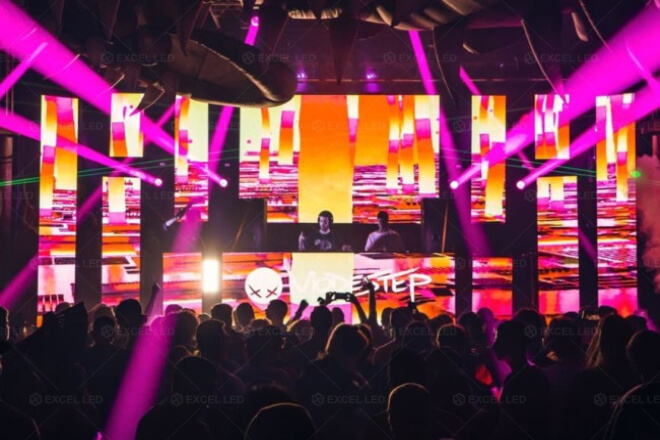
It is not cool enough to install LED screens in bars just to play content. Now, more and more bars are starting to play “black technology” – combining sensor technology to let the screen interact with customers and create a more interesting atmosphere.
For example, the light wall that senses the rhythm of music is a popular way to play. The LED screen automatically changes colour and pattern according to the rhythm of the live music, and can even sense the customer’s movements, making the entire wall “dance along”.
This immersive experience not only attracts customers’ attention but also stimulates their sense of participation, and the atmosphere on the scene becomes lively instantly.
For example, the LED background in the photo area can respond dynamically to the customer’s movements.
When you take a photo, the light, shadow and pattern on the screen will change with your pose or movement.
The photos taken are more interesting and more personalised, and are more likely to become a hit on social media, helping the bar to advertise naturally.
In addition, through QR code interaction, customers can also directly control the screen content with their mobile phones, order songs, vote, send blessings, and even project their own photos or comments on the LED wall in real time.
This social interaction mechanism allows everyone to participate, improves user stickiness, and also increases the fun and vitality of the bar.
Simply put, the combination of LED screens and sensor technology means that the screen is no longer a cold display, but a stage for “dialogue” with customers, enhancing the sense of participation and presence, and improving the overall experience.
This interactive design is a powerful tool for modern bars to attract young people and create a differentiated atmosphere.
Method 6: Update frequency and rhythm design
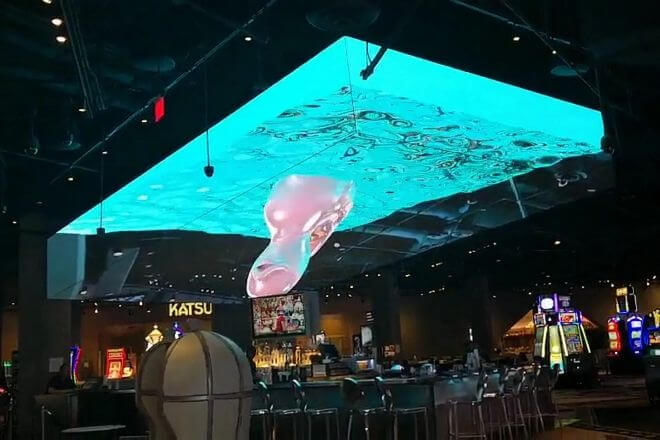
The content of the LED screen in the bar cannot be “once and for all”. If the content remains unchanged, customers will soon turn a blind eye to it, and the screen will become a “background wall” and lose its due value.
Therefore, the frequency and rhythm of content updates are very important. For example, set a few fixed time points every night and switch to different theme content to make customers feel fresh every time they come.
During the Happy Hour period, you can play discount information and relaxed and lively visual animations to attract customers’ attention and consumption.
At midnight, it will turn into a cooler and more dynamic electronic music style picture to match the atmosphere on the scene to reach a climax.
Furthermore, the screen content can also be specially planned according to festivals or theme nights.
At important moments such as Christmas, Halloween, and New Year’s Eve, the visuals and text on the screen should be closely coordinated with the atmosphere to create a “festive sense” and a sense of exclusivity, and enhance the customer’s participation experience.
In addition, the visual styles of different time periods should be reasonably allocated to allow the screen to “breathe” with the rhythm of the bar, so that it will not appear monotonous and boring at low points, nor will it steal the show at high points.
The dynamic content rhythm helps to enhance the atmosphere and layering of the entire bar, and also makes the LED screen a truly indispensable “atmosphere engine”.
In summary, the design of update frequency and rhythm is not only a technical requirement, but also the art of content operation. If done well, the screen can bring freshness every day and firmly grasp the customer’s eyes and mood.
7. الخاتمة
The above methods may make your bar stand out from many competitors. But don’t forget that the real charm comes from the combination of details and creativity.
You might as well start from these ideas and explore your own unique style, so that the LED screen can become the soul of the bar, not just the background.
وأخيرًا، إذا كنت تريد معرفة المزيد عن شاشات العرض LED، يرجى الحصول على اتصال معنا.
